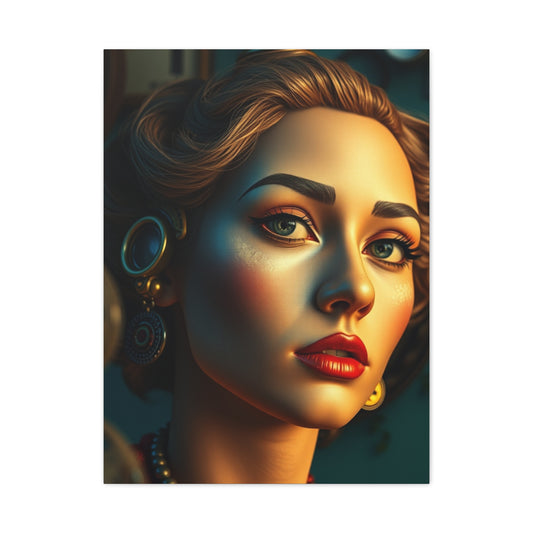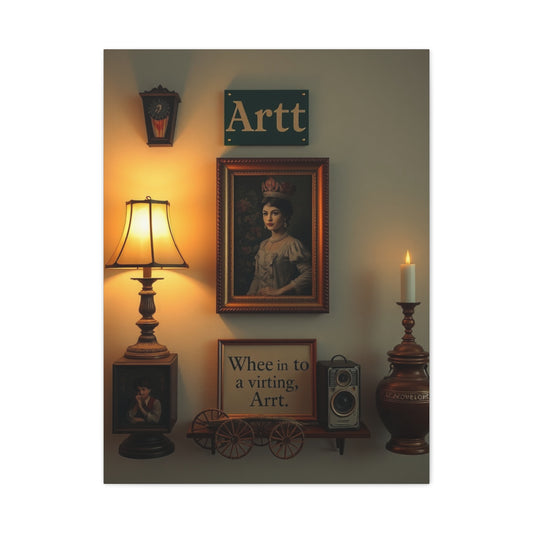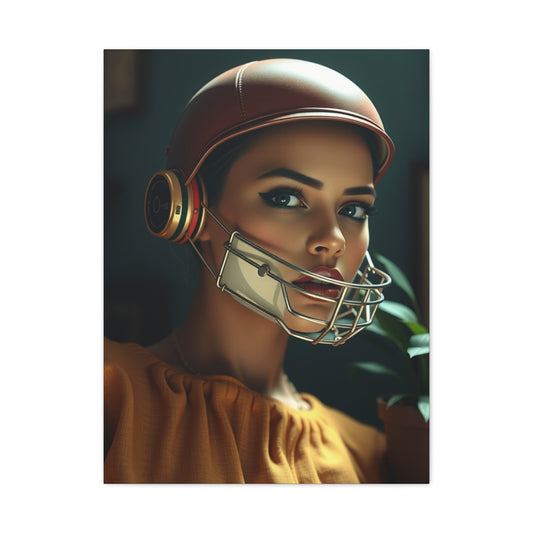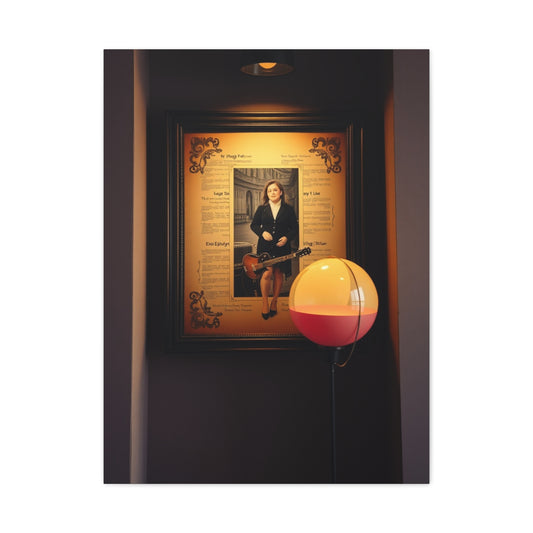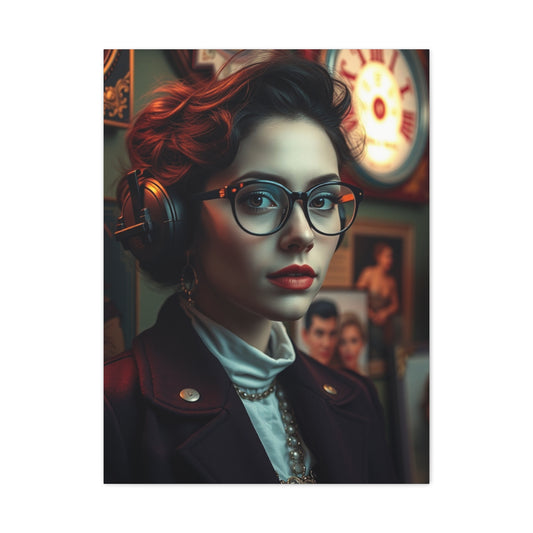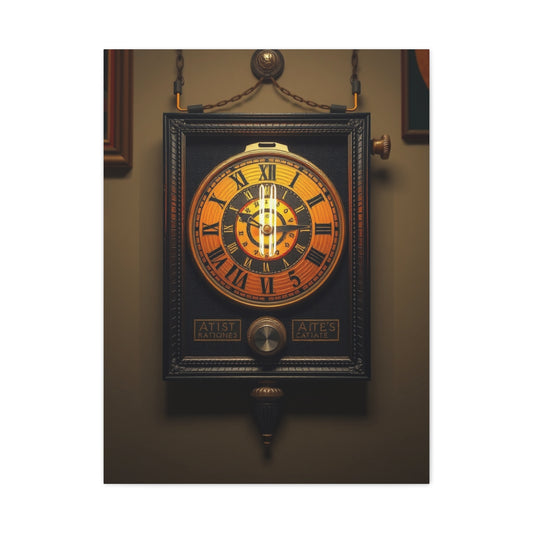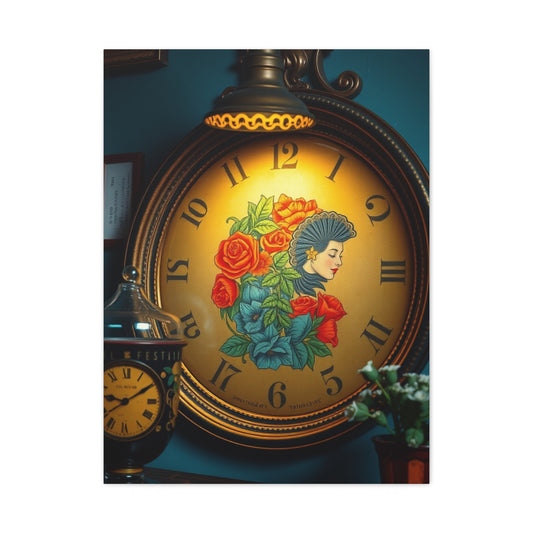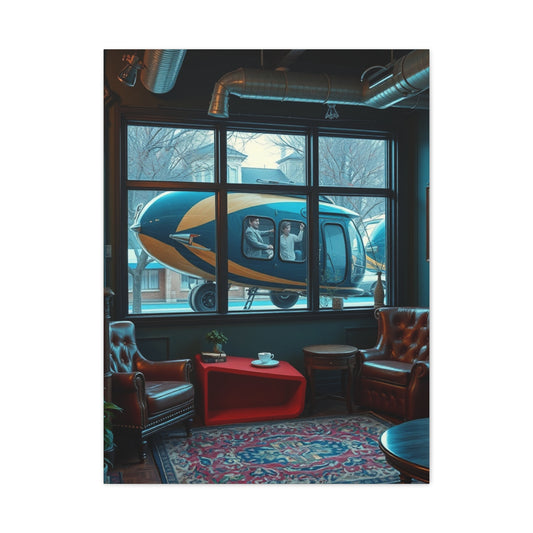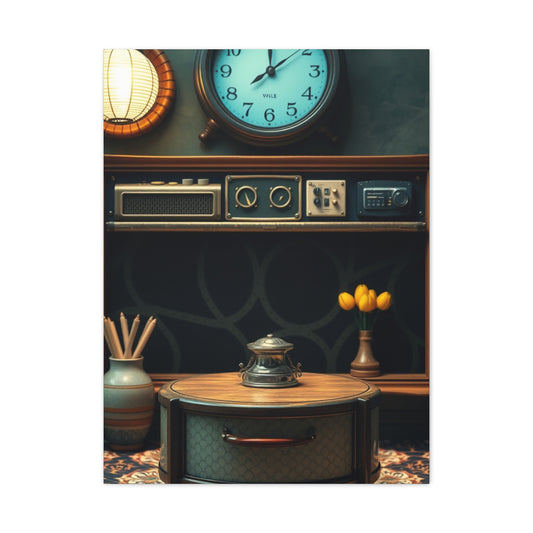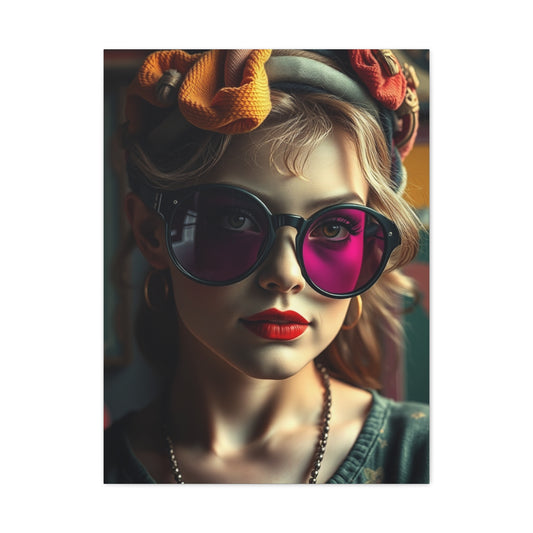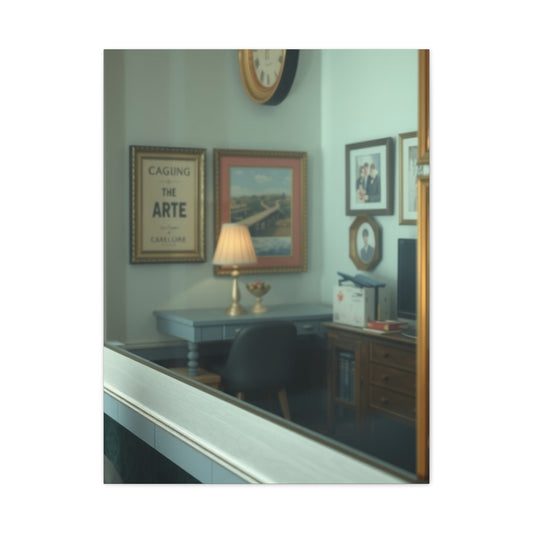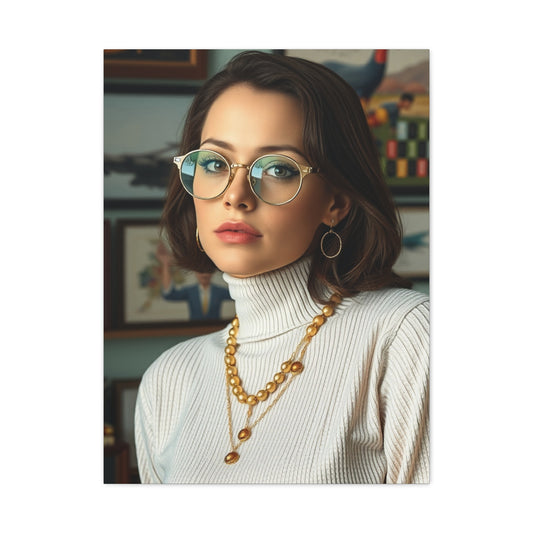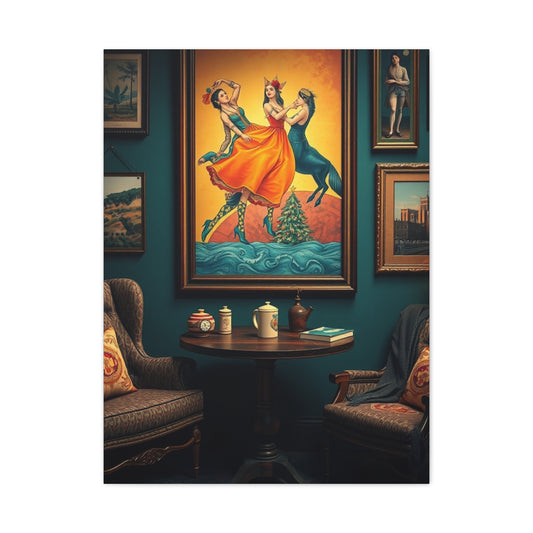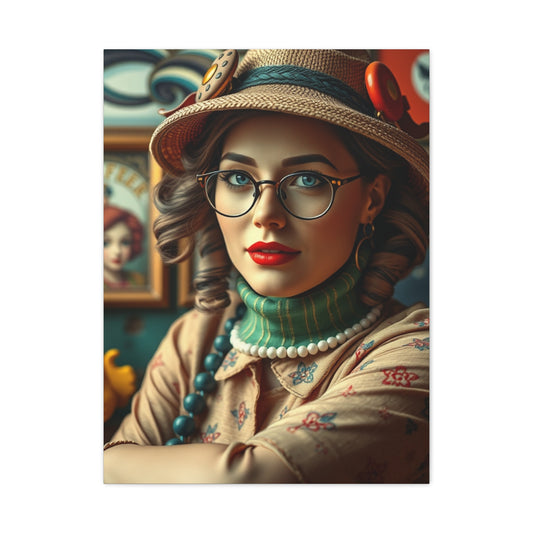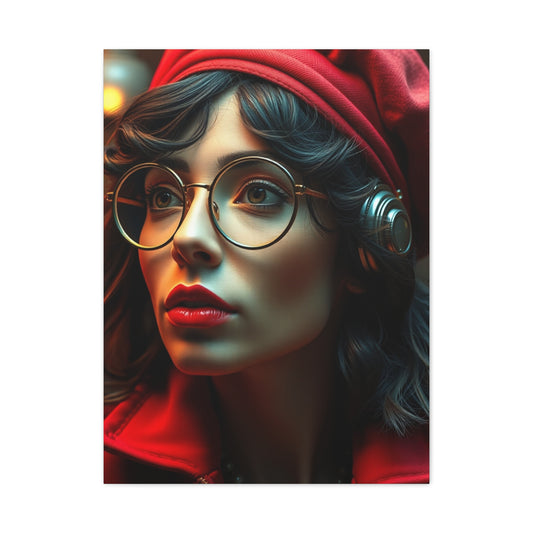Transforming Your Space with Eclectic Vintage Wall Art
Every home possesses a sanctuary, a space that transcends mere function to become a locus of comfort and repose. Within this home, that sanctuary is known as The Cozy Room. Situated just off the kitchen, this room occupies a space often overlooked in architectural design but wholly indispensable in lived experience. The room’s defining feature is a commanding red brick wood-burning fireplace, tucked proudly into a corner, whose warm glow becomes a focal point during the colder months. The hearth acts not only as a source of heat but as an emblem of domestic tranquility, conjuring memories of afternoons spent enveloped in the gentle embrace of warmth and serenity.
The name “The Cozy Room” was not an arbitrary designation. It reflects both utility and sentiment, a testament to how space can accrue meaning through habitual use. Over time, this room has become a crucible for familial interaction, hosting activities that range from leisurely reading sessions and spirited board games to contemplative naps on the expansive sectional sofa. Despite its frequent use, the room underwent a transformation that elevated it from functional to extraordinary—a decision that involved painting the walls a profound shade of black. This audacious choice imparted a sense of drama and intimacy that perfectly aligned with the room’s purpose, turning it into a haven of warmth and refuge.
The Evolution of a Living Space
The transformation of The Cozy Room was neither instantaneous nor preordained. Like many spaces that evolve organically, its current design represents the accumulation of incremental decisions rather than a single moment of inspiration. Initially, the room was functional yet unremarkable, a mere extension of the kitchen rather than a self-contained domain. As time passed, deliberate interventions—carefully chosen furniture, selective decoration, and thoughtful lighting—began to imbue the room with a distinct character. The decision to adopt a dark color palette was particularly pivotal, creating a psychological cocoon that encourages relaxation and prolonged occupancy.
The long and narrow configuration of the room posed a challenge in terms of visual balance. The sectional sofa occupies one of the longest walls, while the fireplace anchors the opposite end. Such spatial dynamics can make expansive walls feel dauntingly empty, fostering a sense of visual dissonance if left untreated. Here, the interplay between scale, texture, and focal points became essential. The goal was not merely to fill the wall space but to cultivate a sense of harmony where emptiness was replaced by visual interest, and where the eye could wander without encountering abrupt voids.
Conceptualizing a Gallery Wall
In addressing the expansive wall, the notion of a gallery wall naturally emerged. Gallery walls serve as both functional and aesthetic devices, converting large, blank surfaces into curated collections that reflect personal taste. However, the conception of such a wall requires careful consideration. The options are manifold: a single monumental canvas can assert dominance, a triptych can introduce rhythm and symmetry, while an eclectic assemblage of frames can cultivate dynamism and intrigue. Each choice carries implicit consequences for spatial perception, color balance, and the psychological impact of the room.
The approach ultimately embraced in The Cozy Room was an eclectic gallery wall, one that could accommodate a diverse array of frames and art pieces. This strategy provided flexibility, allowing the composition to evolve organically without committing to a singular visual motif. Eclecticism, in this context, functions as a balancing act: it harnesses variety without descending into chaos, blending disparate elements into a coherent visual symphony. The process required both audacity and restraint, juxtaposing contrasting textures and finishes while ensuring that the overall composition maintained an underlying cohesion.
Sourcing Frames and Art
The foundation of the gallery wall rested upon a collection of frames and art pieces, many of which were already available. Utilizing existing materials not only minimized expenditure but also allowed for a form of domestic archaeology, wherein each object carried its own history and narrative weight. Larger frames were prioritized for their ability to anchor the composition, while smaller frames provided opportunities for accentuation and counterbalance. Frame finishes were carefully curated; black and gold tones in varying thicknesses created subtle visual dialogue without overwhelming the senses.
Alongside frames, the selection of artwork played a crucial role. Existing art pieces were evaluated for their aesthetic resonance and compatibility with the intended eclectic style. Where gaps remained, new pieces were introduced, often in the form of digital prints that could be printed locally to precise specifications. One particularly notable contribution was a wood canvas from an earlier art school project, which was repurposed and transformed into a contemporary abstract piece. Such creative recycling not only added texture and dimension but also reinforced the ethos of sustainability and resourcefulness.
Planning the Arrangement
With frames and artwork in hand, the next phase involved planning the spatial arrangement. Eclectic gallery walls, while visually diverse, benefit from intentional design. Random placement may produce an appealing sense of casualness, yet deliberate planning ensures balance and visual continuity. In this case, a digital plan was created to simulate the wall above the sectional sofa. Frames were measured and scaled proportionally, allowing for experimentation with positioning before committing to physical installation.
Several methodologies exist for planning a gallery wall. Physical mock-ups on the floor or paper templates on the wall can achieve similar outcomes, but digital tools offer precision and flexibility. Each frame was evaluated not only for its visual appeal but for its spatial relationship to neighboring frames. The goal was to distribute weight, color, and form across the wall in a manner that felt organic yet structured. Even small adjustments in spacing—mere inches—can dramatically alter perception, emphasizing the importance of meticulous attention to detail.
Filling in the Gaps
After arranging the initial frames, it became apparent that additional artwork was needed to complete the composition. Digital prints offered an expedient solution, providing a broad range of stylistic and thematic possibilities. By preassigning each print to a specific frame within the plan, precise dimensions could be ordered, ensuring a seamless fit. This step was critical in maintaining proportional harmony, preventing visual imbalance that could detract from the gallery wall’s impact.
The interplay of old and new, vintage and contemporary, introduced a layered narrative into the room. Each piece contributes its own visual language while interacting with surrounding frames and artworks. Abstract forms contrasted with figurative works, muted tones juxtaposed with brighter accents, and varying textures created depth. This synthesis of elements exemplifies the potential of an eclectic approach, demonstrating that variety, when carefully curated, can cultivate a compelling and cohesive aesthetic.
DIY Enhancements
A distinctive feature of the gallery wall was the integration of do-it-yourself elements. The wood canvas, initially an unfinished or underutilized artifact, was transformed into an abstract composition using neutral paints and textural techniques. Drywall compound added dimensionality, allowing for a tactile experience that contrasted with the flatness of printed works. The process was improvisational yet disciplined, employing layering, scraping, and drybrushing to achieve nuanced effects.
Other frames were similarly adapted. White frames were painted matte black to unify the visual palette, while mat boards were standardized to a cream hue. Such modifications enhanced cohesion across diverse elements, subtly harmonizing differences in scale, texture, and finish. These interventions illustrate the power of minor adjustments to elevate overall impact, demonstrating that thoughtful attention to detail can transform an assortment of disparate objects into a harmonious composition.
Hanging with Precision
The final phase involved mounting the frames with precision. The paper template method proved effective, allowing for trial arrangements on the wall before committing to drilling or nailing. Rectangular cutouts representing each frame were affixed with painter’s tape, facilitating adjustments to spacing, alignment, and height. The level ensured that each frame was parallel and evenly spaced, maintaining visual consistency across the installation.
This careful approach minimized errors and reduced unnecessary wall damage. For heavier frames, drywall anchors provided support, while lighter pieces were secured with standard picture nails. The method exemplifies the intersection of practical considerations and aesthetic sensibility, underscoring the importance of preparation in achieving a polished and enduring result.
The Impact of the Gallery Wall
Upon completion, the gallery wall transformed the room, imparting warmth, character, and a sense of deliberate curation. The large empty wall, once a source of visual tension, became a dynamic focal point, inviting observation and contemplation. The eclectic arrangement allows for continuous evolution, with new pieces easily integrated over time. The combination of existing frames, repurposed materials, and selected prints exemplifies a thoughtful balance of economy, creativity, and personal expression.
Beyond aesthetics, the gallery wall enhances the room’s psychological qualities. The interplay of textures, colors, and forms contributes to an atmosphere of comfort and refuge, aligning with the room’s functional intent. The space now embodies the concept of a sanctuary, demonstrating how careful design interventions, even modest ones, can profoundly influence the experience of domestic life.
Reflections on the Process
The creation of the gallery wall illustrates the interplay between intention, creativity, and adaptability. Each step, from selecting frames and artwork to planning the layout and executing DIY modifications, required a balance of planning and improvisation. The process highlights the transformative potential of thoughtful design, showing how a formerly inert wall can evolve into a site of visual richness and emotional resonance.
The project also demonstrates the value of resourcefulness and sustainability in home design. By repurposing existing frames and materials, integrating DIY elements, and strategically selecting affordable digital prints, the gallery wall achieved significant impact with minimal expenditure. This approach underscores the principle that design excellence does not necessitate extravagance, but rather careful observation, ingenuity, and a willingness to experiment.
Refining the Cozy Room’s Ambiance
The Cozy Room, now distinguished by its eclectic gallery wall, serves as more than a functional family space; it embodies an atmosphere of warmth, intimacy, and subtle sophistication. While the gallery wall provides a visual anchor, the overall ambiance is shaped by the interplay of lighting, furniture placement, and tactile elements. Effective design is rarely static—it evolves with the rhythms of daily life, accommodating new activities, preferences, and decorative aspirations. Achieving this harmony requires attentiveness to scale, texture, and contrast, ensuring that every element contributes to the cohesive identity of the room.
Lighting, in particular, plays a pivotal role in transforming perception. The fireplace naturally produces a flickering, comforting illumination that softens edges and fosters relaxation. Complementing this, strategically positioned lamps and overhead fixtures help balance brightness and shadow, highlighting key elements like the sectional sofa, side tables, and gallery wall without overwhelming the senses. Layered lighting enhances depth, emphasizing textures in the wall paint and artwork while allowing the room to feel simultaneously intimate and expansive.
Furniture Arrangement and Spatial Flow
The sectional sofa, positioned along the room’s longest wall, functions as both a physical and visual anchor. Its placement not only maximizes seating but also delineates zones for different activities—reading, gaming, napping, and conversation. The orientation encourages interaction while simultaneously offering a clear sightline to the fireplace and gallery wall. Balancing the sofa’s mass with lighter furnishings, such as side tables, poufs, and occasional chairs, prevents the space from feeling congested. Thoughtful arrangement ensures fluid movement throughout the room, maintaining an unencumbered passage from the kitchen to the rest of the home.
Spatial flow is further enhanced by the careful consideration of scale and proportion. The room’s elongated dimensions can create a sense of linearity that may feel restrictive if left unaddressed. Here, the gallery wall functions as a horizontal counterbalance, visually expanding the space by drawing attention across its breadth. Complementary decorative elements, such as rugs, throws, and pillows, reinforce this effect, uniting separate zones and providing a sense of continuity while contributing tactile richness.
The Psychology of Color
Color choice is fundamental in establishing mood and psychological resonance within a room. The deep black walls of the Cozy Room exemplify the strategic use of color to evoke intimacy and warmth. Dark tones tend to absorb light, creating a sense of enclosure and comfort, which encourages lingering and relaxation. Simultaneously, the black backdrop serves as a canvas that accentuates the colors, textures, and forms of the gallery wall, allowing each frame and artwork to command attention.
Complementary hues, drawn from the furnishings and artwork, introduce subtle contrast and visual interest. Muted neutrals, rich golds, and occasional pops of saturated color provide balance, preventing the space from feeling oppressive. The interplay of warm and cool tones, in conjunction with texture and pattern, fosters a multidimensional environment that stimulates the senses without inducing overstimulation.
Selecting and Curating Art
A defining feature of the Cozy Room is the eclectic gallery wall, whose effectiveness relies upon the careful selection and curation of art. The process of curating an eclectic wall involves both aesthetic discernment and strategic planning. Each artwork contributes a distinct narrative, medium, or texture, while collectively adhering to an implicit visual grammar. The resulting composition is simultaneously diverse and harmonious, encouraging prolonged observation and engagement.
Sourcing artwork may involve a blend of digital prints, vintage pieces, and repurposed or self-created works. Digital prints offer flexibility, allowing for precise sizing and thematic cohesion. Vintage pieces inject historical resonance and texture, providing layers of visual interest. Repurposed or DIY artwork, such as an old canvas transformed with abstract painting techniques, adds personal narrative and tactile richness. Together, these elements create a gallery that is not static but dynamic, capable of evolving as new pieces are introduced or rotated over time.
Balancing Eclecticism with Cohesion
Eclectic design carries the risk of visual chaos if not carefully managed. Balance is achieved through thoughtful attention to scale, repetition, and color harmony. Frames of varying sizes and finishes can coexist without conflict when strategically arranged, ensuring that weight, shape, and tone are evenly distributed across the wall. Similarly, artwork with different subject matter and textures is juxtaposed to create rhythm and visual dialogue, preventing monotony while maintaining cohesion.
One key technique involves unifying mat boards. Variations in mat tone, if left unaddressed, can create fragmentation and distract from the overall composition. By standardizing the mats in a neutral cream tone, the gallery wall gains a subtle yet significant sense of order, tying together diverse frames and artworks. This practice demonstrates that even small interventions can profoundly influence the perception of an eclectic design, harmonizing contrast without suppressing individuality.
Integrating Textural Layers
Texture is a crucial, often understated component in cultivating a cozy atmosphere. The Cozy Room combines a multiplicity of tactile experiences—from the rough-hewn brick of the fireplace to the soft fabrics of cushions and throws. The gallery wall contributes additional texture, especially through frames with varied finishes and a DIY canvas incorporating drywall compound. This layering of texture engages both sight and touch, enhancing the room’s sensory richness and reinforcing its function as a sanctuary for relaxation and leisure.
Beyond physical texture, visual texture—the perception of surface variation and dimensionality—plays an equally vital role. Prints with intricate patterns, brushwork, or subtle tonal shifts add visual depth, complementing the material surfaces of furniture and architectural elements. The interaction between tactile and visual textures creates a multisensory environment, deepening the room’s immersive quality.
DIY Art and Creative Expression
Incorporating DIY art projects into the gallery wall serves both practical and expressive functions. The process of transforming an old wood canvas into an abstract painting exemplifies the potential for creativity to enliven a space. Techniques such as layering paint, incorporating texture mediums, and experimenting with scraping or drybrushing allow for a unique, personalized result that complements curated artwork. DIY art introduces an element of unpredictability and individuality, reinforcing the eclectic character of the wall while embedding personal narrative into the room.
The act of creating DIY pieces also encourages engagement with the space, fostering a sense of ownership and emotional investment. Home design is not merely a matter of aesthetics; it is a form of lived storytelling, where each object, artwork, and arrangement carries significance. The gallery wall becomes a repository of memory, creativity, and identity, transforming the room into a space that is deeply personal and meaningful.
Planning and Execution Techniques
Effective execution of a gallery wall requires meticulous planning. One proven method involves creating scaled templates of each frame and arranging them on the wall with temporary adhesives such as painter’s tape. This allows for precise adjustments to spacing, alignment, and positioning before committing to permanent installation. Attention to spacing, typically 2 to 3 inches between frames, ensures visual breathing room, preventing congestion and promoting clarity.
Leveling tools and careful measurement are critical for maintaining horizontal and vertical alignment. Heavier frames may require anchors for structural stability, while lighter frames can be mounted with standard nails or hooks. This combination of preparation, precision, and flexibility ensures a polished, enduring result, reflecting both aesthetic intention and practical foresight.
The Interplay of Function and Aesthetics
A key principle in designing the Cozy Room is balancing functionality with aesthetic refinement. The gallery wall, while visually captivating, does not compromise the room’s practical uses. The sectional sofa, reading lamps, and side tables remain accessible and usable, with the art enhancing rather than obstructing daily activities. The room exemplifies a design philosophy that prioritizes livability while cultivating beauty, demonstrating that aesthetic enrichment and practical comfort need not be mutually exclusive.
This interplay extends to materials and finishes. Durable upholstery, easy-to-clean surfaces, and thoughtfully positioned lighting coexist with delicate art, textured throws, and curated decor. Such integration underscores the potential for design to harmonize opposing demands—robustness and refinement, simplicity and complexity, structure and spontaneity.
Psychological and Emotional Impact
The Cozy Room, enhanced by its eclectic gallery wall, exerts a profound psychological and emotional influence on its occupants. The interplay of color, texture, lighting, and curated artwork fosters a sense of safety, comfort, and tranquility. Dark walls evoke intimacy, while the gallery wall introduces narrative depth and visual intrigue. Each element contributes to a holistic experience, engaging multiple senses and encouraging prolonged occupation.
The room’s design also reflects the principle of environmental enrichment, wherein diverse visual stimuli—ranging from artwork and textures to architectural features—support cognitive and emotional well-being. The eclectic gallery wall, in particular, functions as a source of fascination and contemplation, offering subtle rewards upon repeated viewing and encouraging reflection, relaxation, and mental rejuvenation.
Ongoing Evolution and Adaptability
A hallmark of the Cozy Room is its capacity for ongoing evolution. The eclectic gallery wall, by design, permits incremental addition and substitution, allowing the space to adapt to changing tastes, life events, or decorative aspirations. New frames and artwork can be incorporated without disrupting existing harmony, enabling the room to remain dynamic rather than static. This flexibility reflects a broader design ethos in which spaces are conceived as living entities, capable of transformation in response to shifting needs and preferences.
The room’s adaptability also extends to functional arrangements. Seasonal adjustments, such as repositioning lighting, rearranging cushions, or adding textiles, further modulate ambiance and comfort. These subtle interventions illustrate that living spaces are not fixed tableaux but evolving environments that respond to human activity and creative impulses.
Mastering the Art of DIY Creativity
The Cozy Room’s eclectic gallery wall owes much of its personality to the deliberate integration of do-it-yourself creativity. DIY interventions transform ordinary or overlooked objects into artful statements, adding narrative depth and tactile complexity to the environment. The process begins with an assessment of available materials, including frames, canvases, and other artifacts that might be repurposed or reimagined. In this context, creativity is not bound by perfection but guided by intuition, experimentation, and the desire to imbue the room with personal resonance.
One striking example is the transformation of an old wooden canvas into an abstract piece of art. Techniques such as layering paint, applying drywall compound, and experimenting with texture provide a sense of controlled unpredictability. Drybrushing, scraping, and skimming create surfaces that catch light differently, adding a dynamic visual element that evolves with each viewing angle. These textural interventions foster a multidimensional aesthetic, bridging the gap between curated prints and tactile, handcrafted artistry.
Planning for Cohesion and Visual Harmony
Even within an eclectic framework, cohesion remains essential. Diverse artwork, frame finishes, and sizes require strategic placement to achieve visual equilibrium. Spatial relationships are carefully considered, balancing weight, color, and pattern across the gallery wall. Frames with bold or ornate finishes anchor the composition, while smaller, subtler pieces provide rhythm and counterbalance.
Matting plays a subtle yet critical role in unifying the collection. Standardizing mat boards, often to neutral cream tones, helps create visual continuity across disparate frames and artworks. This small intervention mitigates potential dissonance, allowing eclectic variety to coexist with underlying harmony. Such meticulous attention to detail ensures that the gallery wall retains both spontaneity and refinement, providing a visually satisfying experience without appearing haphazard.
Digital and Physical Planning Techniques
The process of arranging a gallery wall is both art and science. Digital planning tools, such as design software or scaling programs, allow precise simulation of layout and proportion. Frames can be scaled and repositioned virtually to explore multiple configurations before committing to physical installation. This methodology ensures that visual weight is balanced, spacing is consistent, and the final composition aligns with the room’s proportions.
For those who prefer tactile approaches, physical planning techniques remain effective. Frames may be laid out on the floor, or paper templates can be affixed to the wall using painter’s tape. This allows adjustments to spacing, alignment, and orientation, while minimizing unnecessary wall damage. In either approach, the objective is the same: to achieve a gallery wall that is deliberate in its composition, dynamic in its effect, and harmonious in its execution.
Filling the Gaps with Thoughtful Selection
An eclectic gallery wall often requires supplemental artwork to fill visual gaps. These gaps provide opportunities to introduce contrasting textures, new color palettes, or thematic variations. Digital prints, for instance, offer customizable dimensions and diverse subject matter, enabling precise integration into the existing arrangement. Vintage pieces or personal creations contribute narrative richness and historical resonance.
The careful selection of these additional artworks ensures that each frame serves a purpose within the broader composition. Color, scale, and thematic relevance are considered in tandem, maintaining visual balance while enhancing depth. Each new piece is an opportunity to refine the gallery’s rhythm, creating a wall that feels both curated and alive.
Integrating Texture and Materiality
Texture is central to the sensory experience of the Cozy Room. Beyond the visual appeal of artwork, tactile surfaces engage the senses, enriching the overall environment. The fireplace’s rough-hewn brick, the softness of cushions, and the layered textiles on the sectional combine with the gallery wall’s varied frames to create a multidimensional space.
Material contrasts amplify the room’s sensory complexity. Smooth digital prints juxtapose with textured DIY canvases, glossy finishes contrast with matte surfaces, and natural wood interacts with painted metal. These material juxtapositions create visual tension and harmony simultaneously, enhancing the room’s richness and inviting prolonged engagement.
Lighting as a Dynamic Element
Lighting in the Cozy Room is designed to complement both the gallery wall and the functional use of the space. Layered lighting, combining ambient, task, and accent sources, allows flexibility in mood creation. The fireplace provides a natural, flickering light that enhances the room’s warmth and intimacy. Adjustable lamps and overhead fixtures highlight key areas, illuminating the gallery wall without overpowering the softer elements of the room.
Dynamic lighting interacts with the textured surfaces of both art and furniture, creating subtle shifts in tone and depth throughout the day. This interplay transforms the perception of the room, making it feel alive and responsive rather than static. Lighting thus becomes not merely functional but an integral design element, shaping both atmosphere and visual narrative.
Furniture and Functional Harmony
The arrangement of furniture in the Cozy Room reflects careful attention to balance and usability. The sectional sofa anchors the space, providing ample seating while delineating zones for reading, conversation, and relaxation. Side tables, poufs, and occasional chairs complement the sectional, creating a layered spatial hierarchy that encourages comfort without overcrowding.
The interplay of furniture with the gallery wall ensures that functional areas do not obstruct visual focal points. The sectional provides a clear line of sight to the wall, encouraging engagement with the artwork. This balance between aesthetic and functional considerations underscores the principle that livability and design excellence are not mutually exclusive but mutually reinforcing.
Seasonal Adaptations and Flexibility
A defining characteristic of the Cozy Room is its adaptability. Seasonal modifications, such as adjusting textiles, lighting, or artwork, allow the space to respond to changing environmental conditions and moods. Throws, rugs, and pillows can be rotated to introduce color variation, while temporary lighting adjustments alter ambiance.
The gallery wall itself is inherently flexible. Additional frames or artworks can be integrated over time, evolving with personal tastes or aesthetic explorations. This capacity for incremental adaptation ensures that the room remains dynamic and relevant, reflecting both current lifestyle needs and long-term design evolution.
Psychological and Emotional Resonance
Beyond its physical attributes, the Cozy Room exerts a profound psychological influence. The combination of dark walls, layered textures, and curated artwork fosters a sense of sanctuary and refuge. Visual engagement with the gallery wall stimulates reflection, curiosity, and emotional connection. The eclectic mix of prints, DIY creations, and vintage pieces cultivates a sense of narrative continuity, embedding personal and historical resonance into the room’s atmosphere.
The room’s design exemplifies environmental enrichment, providing diverse stimuli that enhance cognitive and emotional well-being. The interplay of contrast, texture, and color encourages mindfulness and sustained observation, transforming routine domestic presence into a richer, more engaging experience.
Maintaining the Gallery Wall
Maintaining an eclectic gallery wall requires minimal effort yet thoughtful consideration. Dusting frames regularly preserves visual clarity, while periodic reassessment of arrangement allows the space to remain fresh. DIY pieces or digital prints may be updated or replaced as desired, reinforcing the wall’s capacity for evolution.
The flexibility of the gallery wall ensures that it can accommodate both aesthetic experimentation and practical changes. Frames can be swapped, artworks rotated, and new pieces added without disrupting the overall balance. This adaptability enhances both the longevity and vitality of the room’s design, keeping the space engaging for years to come.
Achieving Balance Between Order and Spontaneity
One of the key challenges in eclectic design is balancing spontaneity with order. The Cozy Room’s gallery wall demonstrates that careful planning can coexist with improvisational creativity. Structured spacing, standardized mat boards, and attention to alignment establish a foundational order. Within this framework, diverse frames, artwork, and textures introduce vitality, ensuring that the composition remains dynamic rather than rigid.
This equilibrium between control and experimentation allows the room to feel intentional yet inviting. Visitors and occupants experience a space that is thoughtfully curated without appearing overly contrived, fostering comfort, engagement, and aesthetic satisfaction.
Sustainability and Resourcefulness in Design
An understated but essential aspect of the Cozy Room is its sustainable approach to design. By repurposing frames, canvases, and materials already in possession, the project minimized waste while maximizing creative output. DIY interventions, digital prints, and selective acquisition of new materials reflect a resourceful philosophy, emphasizing ingenuity and practicality over excessive consumption.
Sustainability in design extends beyond material choices to include adaptability and longevity. The gallery wall’s flexibility, the room’s capacity for seasonal modifications, and the potential for incremental additions ensure that the space remains relevant and vibrant over time. This approach exemplifies a design ethos that values both environmental consideration and long-term functional sustainability.
Fostering Engagement and Creativity
The Cozy Room’s design encourages active engagement with the environment. Whether through interaction with DIY elements, contemplation of curated artwork, or rearrangement of furnishings, the space invites occupants to participate in its ongoing evolution. This participatory quality enhances the sense of ownership and connection, reinforcing the emotional resonance of the room.
Creativity is further stimulated by the eclectic gallery wall, which showcases diverse visual languages and techniques. Exposure to varied textures, compositions, and color palettes encourages reflection, inspiration, and dialogue, enriching both aesthetic appreciation and personal creative exploration.
The Final Flourishes of the Cozy Room
The culmination of the Cozy Room’s evolution lies in the meticulous attention to finishing touches, which harmonize function, aesthetics, and emotional resonance. While the eclectic gallery wall forms the visual and conceptual centerpiece, the surrounding environment—including lighting, textiles, furniture, and small decorative details—contributes to a cohesive, immersive experience. These elements collectively define the room’s character, reinforcing its role as a sanctuary for relaxation, creativity, and familial interaction.
Finishing touches begin with textiles, an often-underestimated element in interior design. Cushions, throws, and area rugs introduce softness and warmth while providing opportunities to incorporate color, pattern, and texture. The interplay of plush fabrics, woven materials, and layered patterns creates a tactile and visual depth that complements the room’s darker walls and eclectic artwork. Carefully chosen fabrics enhance both comfort and style, reinforcing the room’s intimate and inviting atmosphere.
The Role of Lighting in Atmosphere
Lighting continues to play a transformative role, shaping mood and perception. The Cozy Room employs layered lighting strategies that combine ambient, task, and accent sources. Ambient lighting provides general illumination, ensuring visibility and comfort throughout the space. Task lighting, such as reading lamps near the sectional, facilitates specific activities without disturbing the room’s overall ambiance. Accent lighting highlights architectural features, textured surfaces, and particular artworks, drawing the eye to key focal points and enhancing spatial depth.
Lighting design also emphasizes adaptability. Dimmer switches, adjustable lamps, and movable fixtures allow the room to transition seamlessly between functional needs and contemplative moods. The interplay of natural and artificial light interacts with the gallery wall’s frames, artworks, and textures, producing subtle variations that enliven the space throughout the day. This dynamic quality reinforces the Cozy Room’s status as a living, responsive environment.
Achieving Spatial Harmony
Spatial harmony is central to the room’s continued evolution. The sectional sofa serves as a physical and psychological anchor, guiding the arrangement of ancillary furnishings such as side tables, poufs, and occasional chairs. Thoughtful placement ensures smooth circulation, prevents congestion, and establishes clear functional zones for reading, conversation, or quiet reflection.
Proportional balance is achieved through attention to scale and placement. Taller objects anchor vertical sightlines, while horizontal elements, such as the gallery wall, counterbalance elongated dimensions. Rugs and textiles delineate spaces without creating barriers, integrating comfort with visual continuity. Each intervention, no matter how subtle, contributes to the perception of equilibrium, allowing the room to feel expansive while retaining intimacy.
Curating an Ever-Evolving Gallery Wall
The eclectic gallery wall is inherently dynamic, reflecting both past accomplishments and future possibilities. Its structure allows for incremental evolution, accommodating new artwork, frames, or DIY interventions without disrupting the existing arrangement. This adaptability encourages continual engagement, offering opportunities for experimentation, seasonal updates, and creative exploration.
Selecting additions involves careful consideration of scale, tone, and texture. New pieces should harmonize with existing elements while introducing visual interest or narrative complexity. Digital prints, handmade artworks, or repurposed objects can all be integrated seamlessly, ensuring that the gallery wall remains both cohesive and evolving. Over time, this approach fosters a layered aesthetic, embedding memories, creativity, and personal expression into the room’s fabric.
Textural Layering for Depth
Textural layering continues to be a defining characteristic of the Cozy Room. Beyond tactile textiles, texture is introduced through furniture finishes, wall treatments, and varied art surfaces. The gallery wall exemplifies this principle, incorporating frames of diverse materials, finishes, and thicknesses, alongside artworks that range from smooth digital prints to textured, handmade canvases.
The interaction between different textures produces visual rhythm and depth, enhancing the room’s immersive quality. Textural contrasts—such as rough brick, soft upholstery, and the varied surfaces of artwork—engage the senses, inviting observation and tactile curiosity. These layers create a sense of richness that extends beyond mere decoration, transforming the room into a sensory experience that evolves with the viewer’s perspective.
DIY Enhancements and Personal Narratives
DIY elements continue to imbue the room with individuality. The process of creating or modifying artwork, repurposing materials, and experimenting with textures reinforces the gallery wall’s narrative depth. Each DIY piece embodies personal effort and creative decision-making, contributing to the room’s character and emotional resonance.
The integration of DIY artwork also fosters a sense of ownership and engagement. Home design is reframed as an ongoing, participatory process rather than a static arrangement, allowing occupants to leave their mark while responding to evolving aesthetic and functional needs. In this way, the room becomes a repository of creativity, memory, and personal expression.
Maintaining and Preserving the Space
Sustaining the room’s aesthetic and functional integrity requires mindful maintenance. Regular cleaning of frames, dusting of surfaces, and careful preservation of DIY elements ensure longevity. Periodic reassessment of the gallery wall allows for the addition or rotation of artwork, keeping the composition fresh and engaging.
Practical considerations also influence longevity. Durable fabrics, easily cleanable surfaces, and strategically placed furniture prevent wear and damage, maintaining the room’s comfort and visual appeal. This balance of maintenance and adaptability reinforces the Cozy Room’s role as both a functional family space and a curated aesthetic environment.
Seasonal Adaptability
Seasonal shifts provide opportunities to reimagine the room’s ambiance. Subtle changes, such as rotating textiles, adjusting lighting, or introducing seasonal artwork, refresh the space without disrupting its core identity. Layered rugs, throws, and cushions can introduce warmth during winter or a sense of lightness during summer, while temporary decorative interventions complement the gallery wall’s enduring presence.
This adaptability enhances the room’s versatility, allowing it to accommodate different moods, weather conditions, and social scenarios. It also reinforces the concept of the room as a living environment, responsive to both external and internal changes while maintaining its core identity as a sanctuary.
Emotional and Psychological Resonance
The Cozy Room exerts a profound psychological influence, fostering a sense of safety, tranquility, and aesthetic pleasure. Dark walls provide an intimate, enveloping atmosphere, while the eclectic gallery wall stimulates curiosity and visual engagement. Textural contrasts, layered lighting, and thoughtfully arranged furniture create an environment conducive to relaxation, reflection, and social interaction.
The room exemplifies the principles of environmental enrichment, where diverse stimuli—textures, colors, patterns, and narrative elements—enhance cognitive and emotional well-being. Occupants experience both sensory satisfaction and emotional resonance, reinforcing the space’s role as a refuge from the demands of daily life.
Integrating Function and Aesthetic Excellence
The enduring success of the Cozy Room stems from its integration of functionality and aesthetic sophistication. Every element—from furniture placement to gallery wall arrangement—serves both practical and visual purposes. The sectional sofa offers comfort and seating while complementing the visual balance of the room. Textiles enhance tactile comfort while introducing color and pattern. Lighting supports daily activities while shaping mood and perception.
This integration demonstrates that beauty and utility are not mutually exclusive. Thoughtful design can enhance usability without sacrificing aesthetic appeal, creating spaces that are both functional and emotionally satisfying.
Encouraging Engagement and Interaction
The Cozy Room’s design invites engagement, both with the environment and among its occupants. The gallery wall serves as a focal point for observation and conversation, stimulating curiosity and creative dialogue. Furniture arrangements encourage social interaction while providing spaces for solitary reflection. DIY elements and flexible arrangements offer opportunities for creative experimentation and ongoing personalization.
This participatory quality transforms the room from a static space into a living environment, where inhabitants contribute to its ongoing evolution. The result is a home that feels vibrant, responsive, and deeply connected to its occupants’ lifestyles and creative impulses.
Long-Term Vision and Adaptability
Sustaining the Cozy Room’s vitality requires a long-term perspective. The gallery wall’s eclectic nature, combined with the room’s flexible furnishings, ensures adaptability to evolving tastes, activities, and design trends. New artworks can be integrated gradually, DIY projects can be introduced, and seasonal adjustments can refresh the space, all without disrupting the room’s core identity.
This capacity for evolution exemplifies a design philosophy in which interiors are conceived as dynamic systems, capable of growth and transformation. The room’s flexibility ensures that it remains relevant, engaging, and reflective of its occupants’ evolving needs and creative aspirations.
The Intersection of Narrative and Design
A key element of the Cozy Room’s enduring charm is the narrative embedded in its design. Each frame, artwork, and DIY element tells a story, whether of personal creation, historical resonance, or aesthetic preference. The gallery wall functions as a visual chronicle, capturing moments, influences, and creative impulses.
The room as a whole reflects this narrative sensibility. Textures, lighting, and furniture placement are not arbitrary; they reinforce the sense of story, guiding the eye, shaping perception, and encouraging emotional connection. In this way, design becomes a form of storytelling, where every element contributes to a layered, immersive experience.
Conclusion
The journey of transforming the Cozy Room into a sanctuary of warmth, creativity, and aesthetic sophistication illustrates the profound impact of thoughtful design, careful planning, and personal expression. From its origins as a simple bonus space off the kitchen, the room has evolved into an immersive environment where function, comfort, and artistry coexist harmoniously. Central to this transformation is the eclectic gallery wall, which serves not merely as decoration but as a narrative and sensory anchor, providing visual intrigue while reflecting the inhabitants’ creativity and personal history.
The gallery wall exemplifies the delicate balance between eclecticism and cohesion. Diverse frames, repurposed canvases, and curated artworks are united through strategic attention to scale, color, and texture, resulting in a composition that feels both spontaneous and deliberate. DIY projects add further depth, offering tactile richness and personal storytelling that enrich the visual experience. By blending vintage elements, digital prints, and handcrafted pieces, the wall becomes a dynamic, evolving focal point capable of growing with the room and its occupants’ evolving tastes.
Beyond the gallery wall, every aspect of the Cozy Room contributes to its sanctuary-like quality. Layered lighting, textured textiles, and carefully arranged furniture create a balanced environment that invites engagement, relaxation, and reflection. Seasonal adaptations and flexible arrangements further enhance the space’s versatility, ensuring that it remains functional, visually appealing, and responsive to daily needs and changing circumstances. The thoughtful integration of aesthetics and practicality demonstrates that beauty and usability are not mutually exclusive but mutually reinforcing, allowing the room to serve as a hub of both comfort and inspiration.
Ultimately, the Cozy Room is more than a collection of objects or design choices; it is a lived experience that embodies the principles of adaptability, creativity, and mindful curation. The combination of tactile textures, visual variety, and personal narratives cultivates a space that stimulates the senses while offering psychological and emotional respite. This room illustrates how deliberate design interventions—whether through color, texture, lighting, or art—can elevate ordinary spaces into transformative environments that nurture well-being, foster creativity, and sustain a lasting sense of warmth and intimacy. The Cozy Room stands as a testament to the power of thoughtful interior design to create spaces that are beautiful, meaningful, and enduring.

